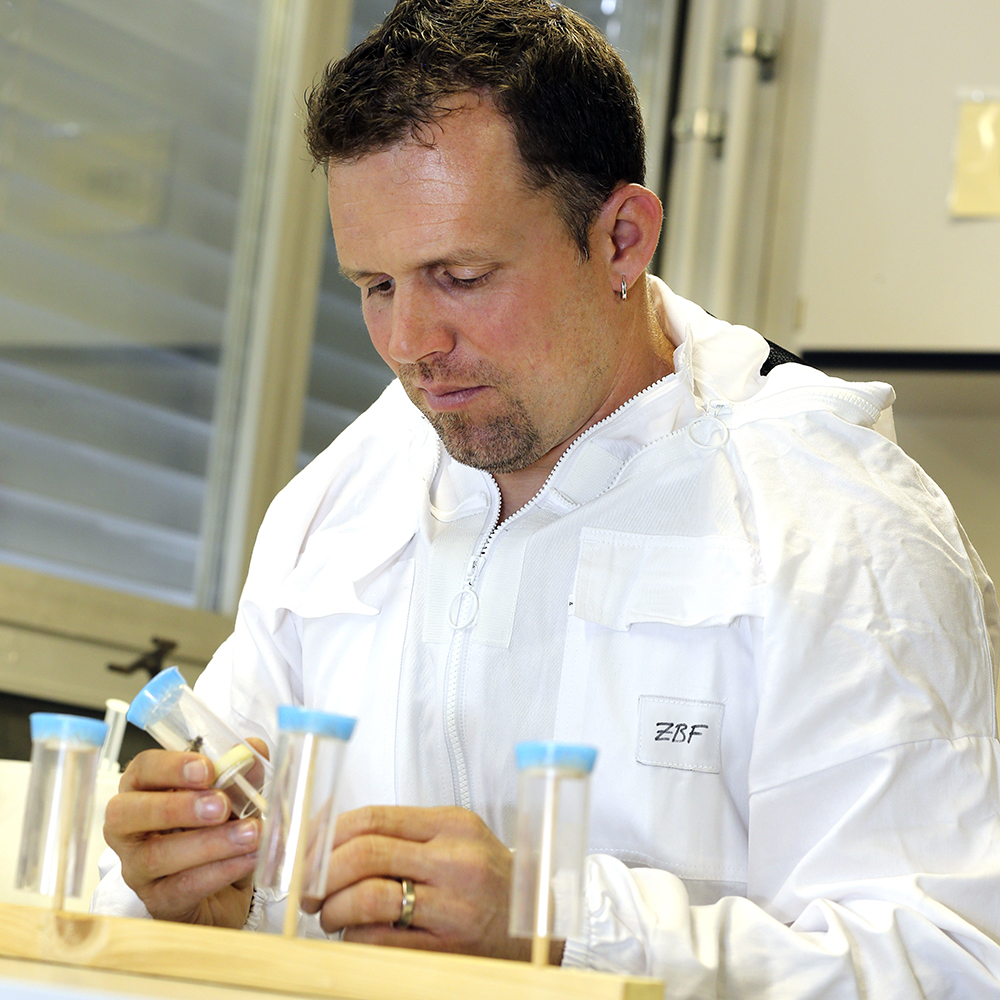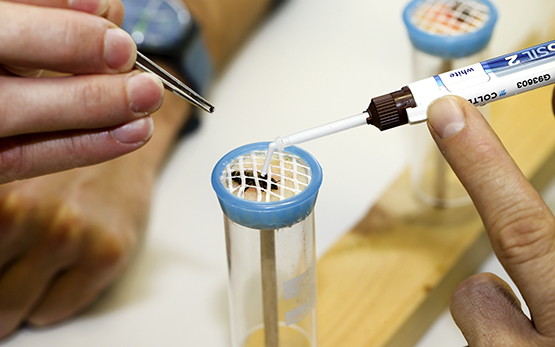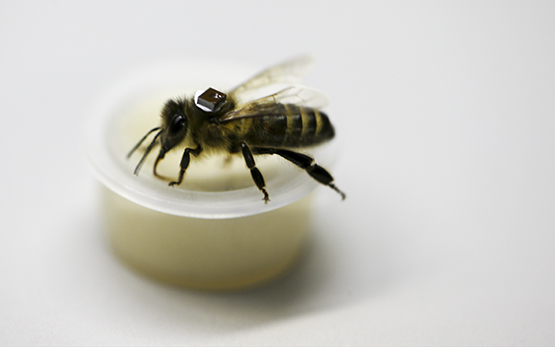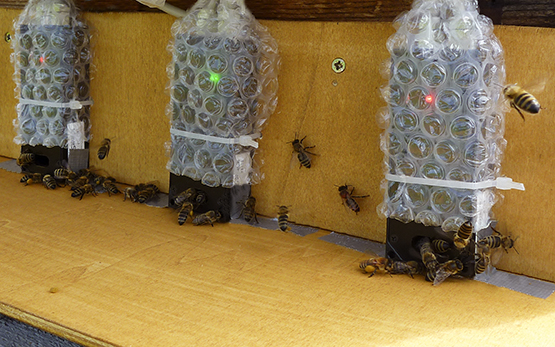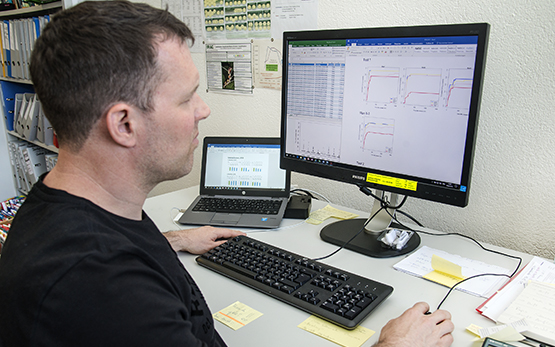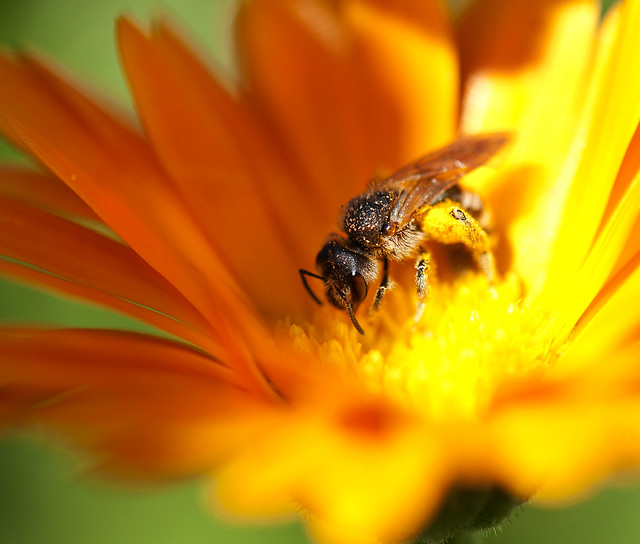Bees may ingest small amounts of plant-protection product residues through pollen or nectar. This is often cited as a possible cause of colony collapse disorder. A newly developed test is meant to show whether feeding small, non-lethal quantities of PPPs to bees influences their orientation- and memory capacity.
Test bees fly to the hive with a microchip on their back. Their flight behaviour is measured, and provides Agroscope researchers with valuable information. The aim here is to determine the risks of PPP residues and help us answer the question of how they affect bees in their natural habitat. Specifically, we determine how many of the test bees return to the hive from a distance of 1km after ingesting a feed solution to which a neonicotinoid has been added, and how long it takes them. “Bees that are familiar with the surroundings normally fly straight back to the hive” says Agroscope researcher Lukas Jeker. The return rate and duration of the journey back to the hive provide valuable information on how well the bees are doing, and whether they can still find their bearings.
RFID Technology
For this, RFID (= radio-frequency identification) technology is used. RFID is an automatic, contactless communication technique that can be used for the identification of people, animals, goods, etc. The technology is well known e.g. in warehouses where it is used to protect goods from theft by triggering an alarm when they are illicitly removed. A similar data medium is now being attached to the backs of test bees. When the bee reaches the hive entrance equipped with the reader, the data can be scanned and identified contactlessly from its ‘barcode’. RFID works with weak electromagnetic waves that are emitted by the reader. To enable the bees to get used to the reader, the technology was installed on the flight board at the hive entrance a few days before the start of the experiment.
Bee research calls for a light touch
“To allow a bee to fly unimpeded, the data carrier must be attached precisely on the bee’s carapace, without adversely affecting its wings or flight musculature. ”These data carriers – also known as transponders or tags – weigh about 4.5 milligrams. “We had to find a way to attach these tags securely to the bee’s back. By now, we’re adept at gently sticking them on there with a bit of tooth cement. The cement dries quickly, and holds reliably. It’s important that the stress this causes for the bees be kept to a minimum, and that the chip not adversely affect their behaviour” explained Jeker, an ecotoxicologist by training.
Problems on the flight home
So far, at the highest dose of 1 ng per bee, the tested neonicotinoid has been shown to have an influence on the return rate, with only 60% of the bees that ingested the highest – and fairly unrealistic – dose flying back to the hive. By contrast, 90% of untreated bees, or those exposed only to the low dose, found their way back to the hive. Other countries had similar findings. From this, we can conclude that the orientation or flight capacity of bees is impaired when they ingest a high concentration of the neonicotinoid.
Participation and co-determination
Conducted by the Bee Research Centre at Agroscope, this study forms part of an international ring test for developing new test procedures for improving PPP risk assessment both in Switzerland and internationally. The ring test is being conducted in twelve laboratories in five countries – Germany, Italy, UK, France and Switzerland – according to the same experimental plan. This means that not only are we studying how technology should be applied in bee research; we are also comparing findings from the different countries in order to test the robustness of the method.
The participation of Agroscope – the Swiss Centre of Excellence in this field, and an independent body – in international ring tests is crucial. It enables new methods, the risk assessment of plant-protection products with regard to bees, and the authorisation of said PPPs to be adapted or conducted with the benefit of our input, and improved according to the latest findings. Data from all participating countries is being compared with the aim of creating a new OECD guideline for the authorisation of plant-protection products.
In 2018, the ring test is being conducted one last time before the method is submitted to the OECD as a new guideline and evaluated. The aim is to enable the RFID test to be used for the assessment of non-lethal effects. This would be an important step in improving bee risk assessment.


